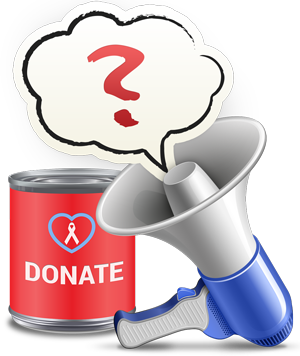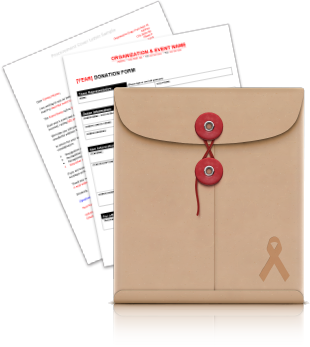
Once you’ve built a wish list of charity auction items you’d like to acquire for your fundraising auction, it’s time to prepare your procurement team to go and get those items.
Asking businesses, organizations or individuals to donate items or services can feel uncomfortable for many people. It’s important to instill a sense of confidence in your team and lead with positive reassurance. Help them understand the importance of “The Ask”.
Remember: If you don’t ask, you don’t get.
8 Tips of an Effective Ask
The way your team approaches potential donors with the procurement packet to ask for contributions largely affects how many times they will hear the word “yes”. To get your team of “solicitors” ready and willing to ask for item donations, offer them some of these useful tips:
1. Be Upfront
Don’t waste people’s time. Instead of beating around the bush, be upfront about the Nonprofit’s cause and why you are trying to raise money.
2. Be Specific
Before you approach a potential donor, have a specific auction item in mind that you want donated (that’s why you created the wish list!). As you are well aware of by now, coming up with ideas for good auction items is difficult, so don’t leave it up to the donor to think of something on the spot. Suggesting a specific item or service will take the pressure off and make it easier for them to say yes.
{{cta(’84dd793b-c26e-4947-b7c1-78a6aa7e77fb’)}}
3. Be Knowledgeable
Be prepared to answer questions about the Nonprofit and its cause. Potential donors are going to ask questions, and those who are interested will no doubt want to learn more about what they are supporting. Create a fact sheet with important statistics and some concise stories to have on hand for reference. If you are coordinating a team, make sure everyone has a copy of this fact sheet, pamphlet or some digital resources to provide a potential donor.
4. Provide Options
When soliciting a business or individual for an auction donation – whether it’s an item, money or service – give them some options to choose from. None of these options should include the answer “No.”
Ask them if they would be willing to help you and help other by supporting your auction, followed by three choices:
- Donate the suggested item
- Donate something comparable
- Underwrite an exciting auction item (like a Winspire Experience!)
- Help you approach a third party to ask for an item
{{cta(‘7a384153-9a97-48ca-b351-1366b97ddf5d’)}}
5. Ask Big!
Tell your team to ask for more than they expect to get. If you ask for dinner for six and you get dinner for four, that’s still great! Ask for what you want, and then take what you can get.
As they say: Shoot for the moon. Even if you miss, you’ll land among the stars.
6. Do the Paperwork
Do all the legwork for the donor – don’t ask them to fill out any forms! This is where being knowledgeable about the cause comes in handy. You can carry on a conversation about your charity and fundraising event while you’re filling out the paperwork.
Gather the information that is absolutely necessary, such as contact and item information, and have them sign the completed form after you filled it out.
7. Get an Answer
Once you’ve made the initial ask, don’t leave until you get a “yes” or a “no”.
You can overcome common objections by waiting patiently until the potential donor either consents or declines your offer. If the first person you encounter says they have to ask the manager or owner who isn’t in at that moment, ask when he/she will be in and then follow up in person or on the phone. In any case, be sure to leave your contact information and an event fact sheet.
8. Understand What “No” Means
What happens if people say “No”? They will, but don’t take it personally.
Author, entrepreneur and marketer Seth Godin puts what ‘No’ really means best:
- I’m too busy
- I don’t trust you
- This isn’t on my list
- My boss won’t let me
- I’m afraid of moving this forward
- I’m not the person you think I am
- I don’t have the resources you think I do
- I’m not the kind of person that does things like this
- I don’t want to open the door to a long-term engagement
- Thinking about this will cause me to think about other things I just don’t want to deal with
What “No” DOESN’T Mean:
- I see the world the way you do, I’ve carefully considered every element of this proposal and understand it as well as you do and I hate it and I hate you.
“The Ask” is one of the most difficult parts about auction item procurement. Some even equate it to the challenges of door-to-door sales, but it doesn’t have to be that way!
If you are prepared, passionate and motivated, and you pass those things along to your procurement team, you have everything you need to succeed in acquiring the best auction items for your event.
 Auction Item Procurement
Auction Item Procurement
Starter Kit

A free resource with helpful templates to get the auction item procurement process off the ground.
We’ve created two general templates for the Procurement Letter and Donation Form to get you started. The Start Kit includes:
- Donation Form TEMPLATE (.docx)
- Procurement Letter TEMPLATE (.docx)
- Procurement Letter Example (PDF)
{{cta(‘c6a87ad6-f268-47fe-a268-839e4f9f9e88′,’justifycenter’)}}
